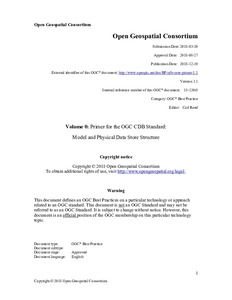| dc.contributor.editor | Reed, Carl | |
| dc.date.accessioned | 2019-07-02T13:11:23Z | |
| dc.date.available | 2019-07-02T13:11:23Z | |
| dc.date.issued | 2018 | |
| dc.identifier.citation | Reed, C. (ed) (2018) Volume 0: Primer for the OGC CDB Standard:
Model and Physical Data Store Structure. Version 1.1. Wayland, MA, Open Geospatial Consortium, 36pp. (OGC 15-120r5). DOI: http://dx.doi.org/10.25607/OBP-508 | en_US |
| dc.identifier.uri | http://hdl.handle.net/11329/974 | |
| dc.identifier.uri | http://dx.doi.org/10.25607/OBP-508 | |
| dc.description.abstract | The CDB standard defines a standardized model and structure for a single, “versionable,”
virtual representation of the earth. A CDB structured data store provides for a geospatial
content and model definition repository that is plug-and-play interoperable between
database authoring workstations. Moreover, a CDB structured data store can be used as a
common online (or runtime) repository from which various simulator client-devices can
simultaneously retrieve and modify, in real-time, relevant information to perform their
respective runtime simulation tasks. In this case, a CDB is plug-and-play interoperable
between CDB-compliant simulators. A CDB can be readily used by existing simulation
client-devices (legacy Image Generators, Radar simulator, Computer Generated Forces,
etc.) through a data publishing process that is performed on-demand in real-time.
The application of CDB to future simulation architectures will significantly reduce
runtime-source level and algorithmic correlation errors, while reducing development,
update and configuration management timelines. With the addition of the High Level
Architecture - -Federation Object Model (HLA/FOM)1 and DIS protocols, the application
of the CDB standard provides a Common Environment to which inter-connected
simulators share a common view of the simulated environment.
The CDB standard defines an open format for the storage, access and modification of a
synthetic environment database. A synthetic environment is a computer simulation that
represents activities at a high level of realism, from simulation of theaters of war to
factories and manufacturing processes. These environments may be created within a
single computer or a vast distributed network connected by local and wide area networks
and augmented by super-realistic special effects and accurate behavioral models. SE
allows visualization of and immersion into the environment being simulated2.
This standard defines the organization and storage structure of a worldwide synthetic
representation of the earth as well as the conventions necessary to support all of the
subsystems of a full-mission simulator. The standard makes use of several commercial
and simulation data formats endorsed by leaders of the database tools industry. A series
of associated OGC Best Practice documents define rules and guidelines for data
representation of real world features.
The CDB synthetic environment is a representation of the natural environment including
external features such as man-made structures and systems. A CDB data store can
include terrain relief, terrain imagery, three-dimensional (3D) models of natural and manmade
cultural features, 3D models of dynamic vehicles, the ocean surface, and the ocean
bottom, including features (both natural and man-made) on the ocean floor. In addition,
the data store can includes the specific attributes of the synthetic environment data as
well as their relationships.
The associated CDB Standard Best Practice documents provide a description of a data
schema for Synthetic Environmental information (i.e. it merely describes data) for use insimulation. The CDB Standard provides a rigorous definition of the semantic meaning
for each dataset, each attribute and establishes the structure/organization of that data as a
schema comprised of a folder hierarchy and files with internal (industry-standard)
formats.
A CDB conformant data store contains datasets organized in layers, tiles and levels-ofdetail.
Together, these datasets represent the features of a synthetic environment for the
purposes of distributed simulation applications. The organization of the synthetic
environmental data in a CDB compliant data store is specifically tailored for real-time
applications. | en_US |
| dc.language.iso | en | en_US |
| dc.publisher | Open Geospatial Consortium | en_US |
| dc.relation.ispartofseries | OGC 15-120r5; | |
| dc.title | Volume 0: Primer for the OGC CDB Standard: Model and Physical Data Store Structure. Version 1.1. | en_US |
| dc.type | Report | en_US |
| dc.description.status | Published | en_US |
| dc.format.pages | 36pp. | en_US |
| dc.description.refereed | Refereed | en_US |
| dc.publisher.place | Wayland, MA | en_US |
| dc.description.currentstatus | Current | en_US |
| dc.description.maturitylevel | Mature: Methodologies are well demonstrated for a given objective, documented and peer reviewed; methods are commonly used by more than one organization (TRL 7-9) | en_US |
| dc.description.bptype | Best Practice | en_US |
| obps.contact.contactname | Carl Reed | |
| obps.contact.contactemail | standards@opengeospatial.org | |
| obps.resourceurl.publisher | http://www.opengeospatial.org/docs/bp | en_US |
 Repository of community practices in Ocean Research, Applications and Data/Information Management
Repository of community practices in Ocean Research, Applications and Data/Information Management
